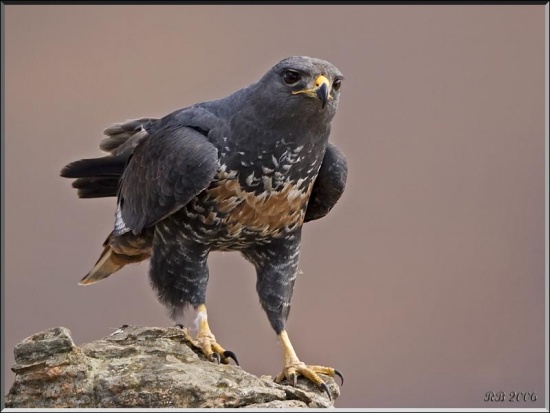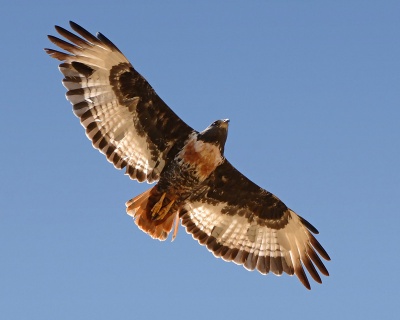| (One intermediate revision by one other user not shown) | |||
| Line 1: | Line 1: | ||
| − | [[ | + | [[Image:Jackal_Buzzard.jpg|thumb|550px|right|Photo by {{user|rudydbn|rudydbn}}<br />Location: Gaints Castle, [[KwaZulu-Natal]], [[South Africa]]]] |
| + | [[Image:12347Jackal_Buzzard_mybs_Stellenbosh.jpg|thumb|400px|right|Photo by {{user|mybs|mybs}}<br />Location: Near Stellenbosch, [[South Africa]]]] | ||
;[[:Category:Buteo|Buteo]] rufofuscus | ;[[:Category:Buteo|Buteo]] rufofuscus | ||
| − | |||
| − | |||
==Identification== | ==Identification== | ||
| − | Length 44-55 cm, mass 0.9-1.7 kg. Females larger than males. The wings are broad and the tail short | + | Length 44-55 cm, mass 0.9-1.7 kg. Females larger than males. The wings are broad and the tail short. |
| − | ''' | + | '''Adult''': Black above with a chestnut tail. The chin and throat are black and the breast is rich rufous, bordered by white feathers. The underwing coverts are black and the flight feathers from below are white (white barred black from above), tipped with black to form a dark trailing edge to the wing. '''White-breasted morphs''' occur, and sometimes the entire underparts are white. '''Dark morphs''' with underparts that are mostly black have also been observed, but are rare. |
| + | '''Juvenile''': Mainly brown above and rufous brown below and on the tail. | ||
==Distribution== | ==Distribution== | ||
| − | Southern [[Africa]]: Widespread in [South Africa]], [[Lesotho]], and [[Swaziland]]. More thinly distributed in [[Namibia]]. The edge of its range extends marginally into [[Botswana]], [[Zimbabwe]] and [[Mozambique]]. | + | Southern [[Africa]]: Widespread in [[South Africa]], [[Lesotho]], and [[Swaziland]]. More thinly distributed in [[Namibia]]. The edge of its range extends marginally into [[Botswana]], [[Zimbabwe]] and [[Mozambique]]. |
==Taxonomy== | ==Taxonomy== | ||
Closely related to (and sometimes lumped with) [[Augur Buzzard]] ''Buteo augur''. | Closely related to (and sometimes lumped with) [[Augur Buzzard]] ''Buteo augur''. | ||
| Line 23: | Line 23: | ||
'''Breeding''': They build a 1-metre wide stick nest in a tree or on a crag; it is often reused and enlarged in subsequent seasons. 2 creamy or bluish white eggs are laid and incubated by the female only; food is brought to her on the nest by the male. The eggs hatch in about 40 days, and after a further 56-60 days they can attempt flight. At 70 days they become independent of the nest, but young birds may then be seen with the adult pair for some time. | '''Breeding''': They build a 1-metre wide stick nest in a tree or on a crag; it is often reused and enlarged in subsequent seasons. 2 creamy or bluish white eggs are laid and incubated by the female only; food is brought to her on the nest by the male. The eggs hatch in about 40 days, and after a further 56-60 days they can attempt flight. At 70 days they become independent of the nest, but young birds may then be seen with the adult pair for some time. | ||
==References== | ==References== | ||
| − | Claassens A & Marais E. 2008. Species information page - Jackal Buzzard. SASOL Bird e-Guide. http://www.birdlife.org.za/fieldguide/book/species_info.php?id=96. Downloaded 25 January 2008. | + | # Claassens A & Marais E. 2008. Species information page - Jackal Buzzard. SASOL Bird e-Guide. http://www.birdlife.org.za/fieldguide/book/species_info.php?id=96. Downloaded 25 January 2008. |
| − | + | # Hockey PAR, Dean WRJ & Ryan PG (eds) 2005. Robert's Birds of Southern Africa, 7th edition. John Voelcker Bird Book Fund, Cape Town, South Africa. ISBN 0620340533 | |
| − | Hockey PAR, Dean WRJ & Ryan PG (eds) 2005. Robert's Birds of Southern Africa, 7th edition. John Voelcker Bird Book Fund, Cape Town, South Africa. ISBN 0620340533 | ||
==External Links== | ==External Links== | ||
{{GSearch|Buteo+rufofuscus}} | {{GSearch|Buteo+rufofuscus}} | ||
| − | [[Category:Birds]] | + | [[Category:Birds]][[Category:Buteo]] |
Revision as of 17:34, 1 November 2008
- Buteo rufofuscus
Identification
Length 44-55 cm, mass 0.9-1.7 kg. Females larger than males. The wings are broad and the tail short.
Adult: Black above with a chestnut tail. The chin and throat are black and the breast is rich rufous, bordered by white feathers. The underwing coverts are black and the flight feathers from below are white (white barred black from above), tipped with black to form a dark trailing edge to the wing. White-breasted morphs occur, and sometimes the entire underparts are white. Dark morphs with underparts that are mostly black have also been observed, but are rare.
Juvenile: Mainly brown above and rufous brown below and on the tail.
Distribution
Southern Africa: Widespread in South Africa, Lesotho, and Swaziland. More thinly distributed in Namibia. The edge of its range extends marginally into Botswana, Zimbabwe and Mozambique.
Taxonomy
Closely related to (and sometimes lumped with) Augur Buzzard Buteo augur.
Buteo rufofuscus is monotypic.
Habitat
Mainly hills and mountains, although non-breeding adults and juveniles can be found in flat terrain. The species prefers short vegetation, ranging from fynbos, Karoo and semi-desert to open woodland and grassland.
Behaviour
Small ground mammals make up about 65% of the diet, but snakes, lizards, small ground birds, insects, and road-kill are also taken. Typically, the raptor drops on its prey after 'hanging' on an updraft, from a hover, or from a perch.
Call: A loud, yelping 'keeooow', similar to the call of the Black-backed Jackal.
Breeding: They build a 1-metre wide stick nest in a tree or on a crag; it is often reused and enlarged in subsequent seasons. 2 creamy or bluish white eggs are laid and incubated by the female only; food is brought to her on the nest by the male. The eggs hatch in about 40 days, and after a further 56-60 days they can attempt flight. At 70 days they become independent of the nest, but young birds may then be seen with the adult pair for some time.
References
- Claassens A & Marais E. 2008. Species information page - Jackal Buzzard. SASOL Bird e-Guide. http://www.birdlife.org.za/fieldguide/book/species_info.php?id=96. Downloaded 25 January 2008.
- Hockey PAR, Dean WRJ & Ryan PG (eds) 2005. Robert's Birds of Southern Africa, 7th edition. John Voelcker Bird Book Fund, Cape Town, South Africa. ISBN 0620340533





